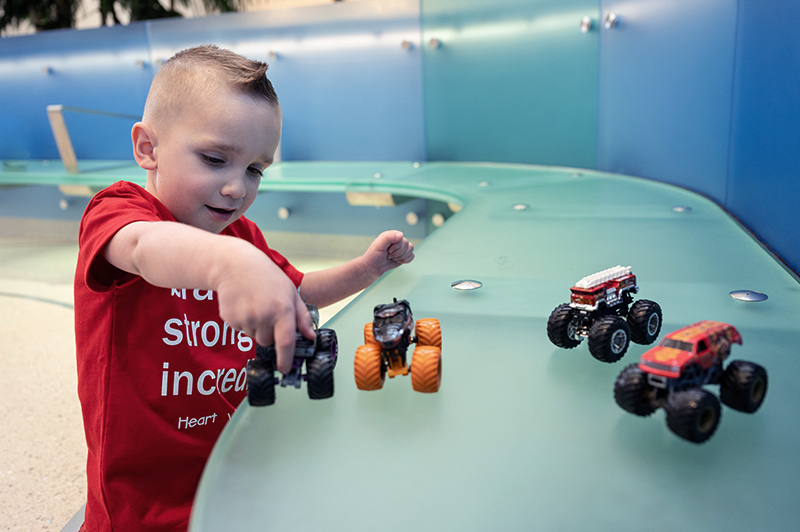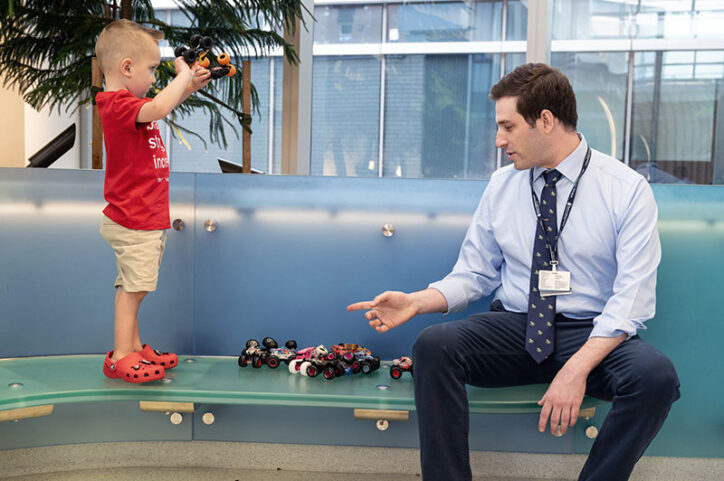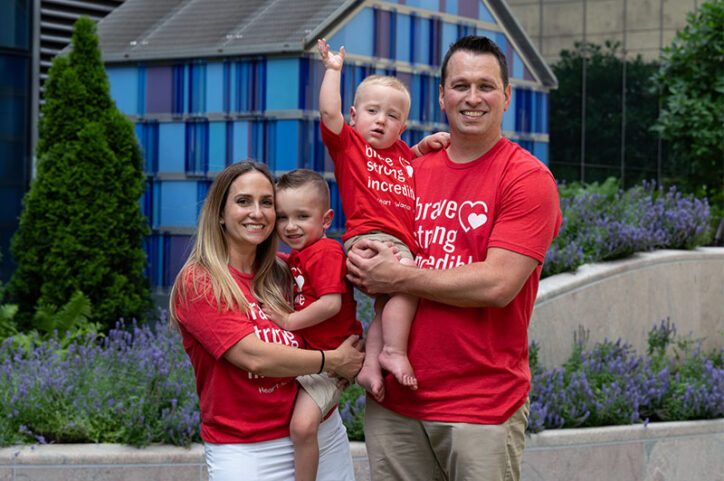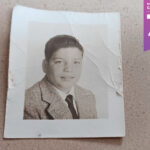Jack had a first-of-its-kind surgery with the aim of making it his last

Jack Mangan loves fire trucks. He also loves monster trucks. So you can imagine his excitement about those two things being mashed up as a toy: a fire truck on top of a monster truck.
The 4-year-old has an extensive collection of miniature hybrid monster trucks — one has a shark on top; another Scooby-Doo — and he couldn’t wait to bring many of them to a recent checkup at the Benderson Family Heart Center. His joy and good health are just what his parents and cardiac care team hoped they would see when Jack had a partial heart transplant earlier this year.
While it is the first such transplant in New England, Jack’s parents, Amy and Chris, are hoping it is the last heart surgery their son will need. That’s the potential benefit of him having a relatively new procedure over proven ones that still leave a door open for further surgery. The partial transplant gave Jack a healthy aortic valve from a donor. The valve is expected to grow along with him and minimize the need for future cardiac procedures.
“It was the hardest thing we’ll ever do, but it will be the best thing we’ll ever do,” Amy says of their decision to proceed with the partial heart transplant. “When your child has endured so much and doing things that didn’t seem possible, it’s the most incredible feeling in the world.”
Intervening during pregnancy gave Jack a head start
A fetal echocardiogram 20 weeks into Amy’s pregnancy revealed Jack had advanced aortic valve stenosis, a narrowing of the valve that prevents blood from nourishing the body. The disease can also diminish the blood-pumping ability of the heart’s left ventricle as part of a serious condition known as hypoplastic left heart syndrome (HLHS). A cardiologist at a pediatric hospital near the Mangans’ New Jersey home told Amy and Chris there was nothing they could do, but said the family could possibly get help from Boston Children’s Fetal Cardiology Program.
After reaching out, Amy and Chris quickly heard back from Dr. Wayne Tworetzky, director of the program and part of a team that, in 2001, performed the first successful fetal cardiac intervention in the country. Guided by an ultrasound image, it is a needle- and catheter-based procedure that can treat some life-threatening heart problems in a fetus. Six days after that conversation, the cardiac intervention was successful, but weeks later, one of Amy’s frequent echocardiograms back home showed the aortic valve again closing. Dr. Tworetzky recommended a second fetal cardiac intervention, which this time prevented the aortic valve from narrowing further and allowed Jack’s left ventricle to grow properly.
After Jack was born, he was closely monitored by Boston Children’s Maternal Fetal Care Center (MFCC), in affiliation with Brigham and Women’s Hospital. His birth brought good news: He had avoided HLHS and had a “full heart.” But as he matured, Jack still had residual aortic valve disease, even after cardiac surgeon Dr. Sitaram Emani performed separate surgical repairs on the valve. Dr. Emani and Jack’s Boston Children’s cardiologist, Dr. Matan Setton, determined that further repairs wouldn’t help. Jack would need a replacement aortic valve.

Jack’s parents consider a new but unproven procedure
Amy and Chris delayed making a difficult decision. At the time, it appeared the best available replacement option would be the Ross procedure. That’s because two common replacement valve options have drawbacks. A mechanical aortic replacement valve requires long-term anticoagulation. A bioprosthetic (cow or pig) replacement valve doesn’t require long-term anticoagulation, but it has a shorter lifespan than a mechanical one. Both replacement valves have another limitation: They are often too large to place in young children.
Amy and Chris considered how the Ross offers far more time because the patient’s own pulmonary valve, their own natural tissue, takes the place of the diseased aortic valve. But the drawback for them was that the replacement pulmonary valve, usually donated from a cadaver, would not grow with Jack and would eventually fail, likely requiring additional replacement operations during his lifetime.
“Our goal was to give Jack the highest quality of life as possible with the least number of interventions,” Amy says. Taking their time thinking about the Ross procedure worked in their favor. Recognizing their struggle, Dr. Setton mentioned a fourth way, the relatively new partial heart transplant procedure. Duke University Hospital performed the world’s first partial heart transplant in 2022; Boston Children’s established protocols for the procedure eight years ago and was waiting for an ideal patient for its first.
A partial heart transplant replaces a diseased valve with a healthy valve from a donor. The promise of the procedure is the new valve will grow with a child because it is living tissue. (The donor valve has grown with the newborn who had the partial transplant at Duke.)
“We’ve had to make a lot of hard decisions through the years, but this was the hardest one,” Chris recalls. “The Ross is a proven method, and it’s been successful for many children. But Dr. Setton felt strongly that a transplant would help Jack’s condition.” Despite the unknowns, Amy and Chris agreed to a partial heart transplant because Drs. Setton and Emani believed it could potentially be the last operation Jack would need.
A successful partial heart transplant — and a request for tortilla chips
The call came in May. A donor heart was on its way to Boston Children’s. Chris rushed out of a work meeting in Manhattan, and soon, he, Amy, Jack, and Jack’s baby brother, Declan, started their journey through heavy traffic. Jack wondered why he couldn’t have a drink while Declan did. Amy explained: “You know you have a special heart. You have a little boo-boo, and now Dr. Emani is going to fix it.”
Hours later, Dr. Emani and his surgical team did fix it, working through the middle of the night as they removed Jack’s aortic valve and implanted the donor’s valve. They then attached Jack’s coronary arteries to the new aorta. Because it was a partial heart transplant, the full dosage of immunosuppressive medication Jack takes now will probably be lessened if his body doesn’t show signs of rejecting the new valve. So far it hasn’t, and the aortic valve is fully functional.
After being denied water on the ride to Boston, Jack’s first words after the operation were, “Can I have tortilla chips?” Amy recalls, “It made everyone laugh. Jack was back.”

Gratitude for a donor and a helpful heart team
While it’s a happier time for the Mangans, Amy and Chris are aware of the pain the donor’s family is facing. “I pray for them every day,” Amy says. “That day, their hearts broke while our little boy was saved. It’s an emotional part of this procedure. I give all donors and their families so much credit. It’s the most selfless thing you could do.”
Jack enjoys traveling to Boston Children’s for follow-up visits because it means he gets to show off his monster truck toys. He also likes Boston because during one of the family’s visits, firefighters let Jack sit in a fire truck and he hasn’t forgotten the experience. Fire stations are on the itinerary of each trip. Of course, Jack wants to be a firefighter when he grows up.
Hearing him make plans for the future and watching him run around with energy — the surest signs of good health — make Amy and Chris grateful for the care he has received and continues to receive at Boston Children’s.
“We tell everyone what a wonderful facility it is,” Chris says. “We’re very blessed to have the team we have. We didn’t know what we were getting into that first day when we met with Dr. Tworetzky. But he, Dr. Setton, Dr. Emani, all the nurses, the entire staff — everyone has gone above and beyond to help us.”
Learn more about the Congenital Heart Valve Program or refer a patient.
Related Posts :
-

Eight years of preparation for a surgical first: a partial heart transplant
Boston Children’s cardiac surgeons have an overriding goal for each patient: If possible, repair their congenital ...
-

A 'super' new heart surgery for a super kid
When you’re the first person in the world to undergo a new type of heart surgery, you don’t ...
-

Ted Williams, chocolate milkshakes, and a pioneering heart team: What Bruce remembers about his heart surgery 65 years later
Bruce Chansky was the star of his neighborhood after he had heart surgery at Boston Children’s. It was 1959, a ...
-

Twenty years after a groundbreaking biventricular repair, Faith gives back by helping children with CHD
Faith Brackett doesn’t remember every detail of the time she was among the first children to have a new ...





